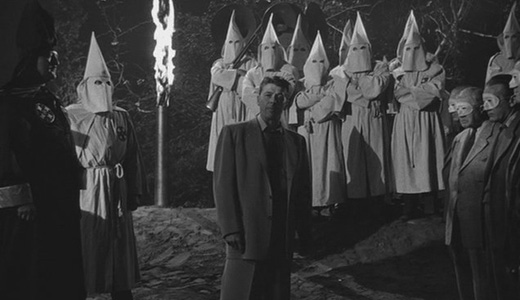
In a discussion of progressive cinema one is not likely to mention the name of Ronald Reagan. But you would be remiss if you did not mention the 1951 film, Storm Warning, in which Reagan portrays a district attorney crusading against the Ku Klux Klan.
Reagan’s terms as U.S. president were marked by Cold-War sabre-rattling, support for Latin American death squads and dictators, and union-busting. His term as president of the Screen Actors Guild was perhaps the most shameful in the history of the organization and is best remembered for his stoking of the anti-free-speech flames of the notorious Hollywood anti-Communist witch hunts and blacklist. His film career, sometimes by his own admission, was a mixed bag at best. His appearance in Storm Warning, however, is not only worth noting but worth digging through the DVD vaults to have a look.
The film opens with a character portrayed by Ginger Rogers completing a long bus trip to visit her sister in a small town. Interestingly, despite the subject matter of Klan terrorism, there is nothing to indicate that the town is in the South, it could just as easily be Indiana or Nebraska.
The film is directed by Stuart Heisler, whose previous credits included the 1944 documentary The Negro Soldier. Here Heisler does an excellent job of making the audience pensive when Rogers arrives in the dead of night and finds the locals to be so tense and terse she has difficulty even hiring a cab. It isn’t long before we learn what has everyone on edge. The Klan is about to strike and Rogers winds up witnessing the lynching of a journalist who was writing a Klan expose.
Undetected by the murderers, Rogers flees the scene and manages to reach the home of her sister, but is even more shocked to meet her new brother-in-law who was one of the hooded killers she saw carry out the evil deed. Actor Steve Cochran, who made something of a career as a rough-hewn B-movie heartthrob, is particularly good in the role of the loutish brother-in-law.
Regrettably, the film does not confront the Klan’s evil ideology of racism and anti-Semitism, and there are no significant African-American characters in the picture. Instead it presents the Klan as a corrupt racket, exploiting the uninformed for its own purposes. The film is fairly effective, however, in showing how local members of the ownership class use the Klan to extend their power.
One scene that is particularly good takes place in a mill, owned by the local Klan leader, and used by the leadership to discuss how to hold the organization together under the pressure of the district attorney’s investigation. One of them expresses his concern that the membership is made up of those weak in both mind and spirit, commenting, “You know the boys, they’re no heroes.”
Perhaps the most chilling scene comes when the film imitates a scenario that was played out countless times in real-life capitalist America, when a friendly inquest left an obvious crime “unsolved.” Local Klansman erupt in an all-night celebration of their successful manipulation of the justice system, one of them repeatedly crying out in drunken mockery the official conclusion that the crime was committed by “assailant or assailants unknown!”
Reagan’s best scene comes near the end of the film, when he confronts the Klan at an outdoor rally. As the KKK leader begins to offer a verbal threat punctuated with Klan jargon Reagan brushes him off saying, “Don’t give me that Halloween routine, why don’t you just admit you’re a mean group of frightened little people or you wouldn’t be here desecrating the cross.”
In my hometown, during the Reagan presidency, one of the local TV stations frequently aired Storm Warning as a late-night movie offering. Watching Reagan the actor confront the Klan was much more pleasant than watching Reagan the president confront unions, women, and the peace movement. Today the film remains an interesting footnote in the career of a disgraceful politician whom historical revisionists are hard at work trying to rehabilitate.
Image: Ronald Reagan stands among hooded Klansmen in the movie “Storm Warning.” (scroll down to the very bottom of the page for the movie still of Reagan standing among hooded Klansmen)







